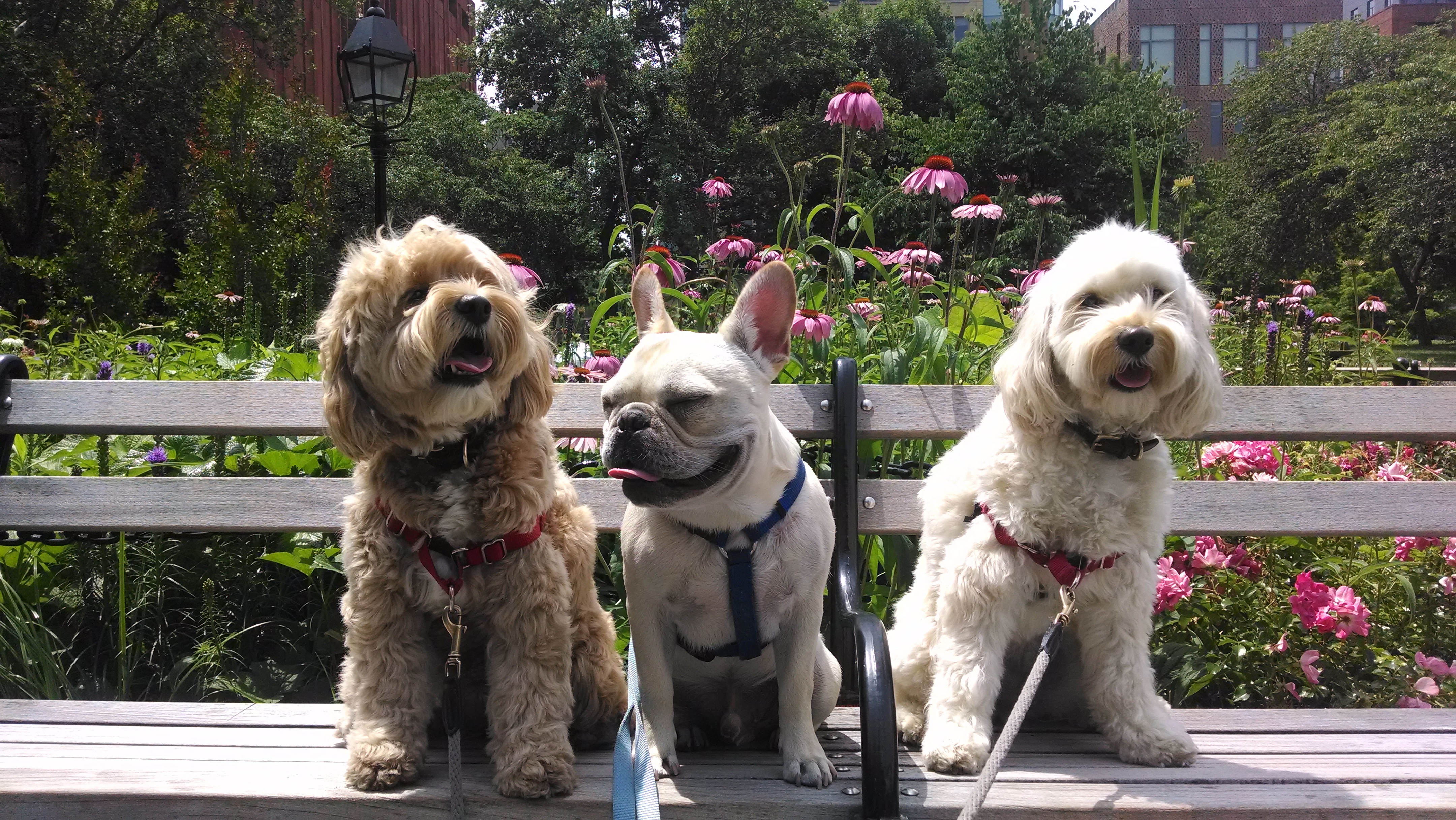
17 Mar Should My Dog Walk In Groups?
No one knows your dog better than you! Even though we all want to spend 24/7 with our furry babies we aren’t going to delude ourselves – we have full time jobs and have to leave them in the precious care of others. It’s important to ensure your dog’s happiness while they are being cared for, and one important factor of dog care is the walk. So, should your dog walk in a group with other dogs?
Ask Your NYC Dog Walker
The first step should be to know what happens on your dog’s daily walk. A simple email to your walker asking for details is a great way to start. Does he/she take out more than one dog at a time? How many, tops? How big or small are the other dogs in the pack? For example: a small dog may be anxious and afraid of dogs twice his size, and vise-versa. Where do they go? And how does your dog do while walking? Does your walker see any signs of discomfort or anxiety? A simple conversation can really bring out a lot about how your doggy acts when you aren’t around. If your walker mentions behavior you haven’t seen before, or seems unusual, it’s worth poking a little deeper to find out what your baby needs.
No one knows your dog better than you! Even though we all want to spend 24/7 with our furry babies we aren’t going to delude ourselves – we have full time jobs and have to leave them in the precious care of others. It’s important to ensure your dog’s happiness while they are being cared for, and one important factor of dog care is the walk. So, should your dog walk in a group with other dogs?
Ask Your Dog Walker
The first step should be to know what happens on your dog’s daily walk. A simple email to your walker asking for details is a great way to start. Does he/she take out more than one dog at a time? How many, tops? How big or small are the other dogs in the pack? For example: a small dog may be anxious and afraid of dogs twice his size, and vise-versa. Where do they go? And how does your dog do while walking? Does your walker see any signs of discomfort or anxiety? A simple conversation can really bring out a lot about how your doggy acts when you aren’t around. If your walker mentions behavior you haven’t seen before, or seems unusual, it’s worth poking a little deeper to find out what your baby needs.
No one knows your dog better than you! Even though we all want to spend 24/7 with our furry babies we aren’t going to delude ourselves – we have full time jobs and have to leave them in the precious care of others. It’s important to ensure your dog’s happiness while they are being cared for, and one important factor of dog care is the walk. So, should your dog walk in a group with other dogs?
Ask Your Dog Walker
The first step should be to know what happens on your dog’s daily walk. A simple email to your walker asking for details is a great way to start. Does he/she take out more than one dog at a time? How many, tops? How big or small are the other dogs in the pack? For example: a small dog may be anxious and afraid of dogs twice his size, and vise-versa. Where do they go? And how does your dog do while walking? Does your walker see any signs of discomfort or anxiety? A simple conversation can really bring out a lot about how your doggy acts when you aren’t around. If your walker mentions behavior you haven’t seen before, or seems unusual, it’s worth poking a little deeper to find out what your baby needs.
No one knows your dog better than you! Even though we all want to spend 24/7 with our furry babies we aren’t going to delude ourselves – we have full time jobs and have to leave them in the precious care of others. It’s important to ensure your dog’s happiness while they are being cared for, and one important factor of dog care is the walk. So, should your dog walk in a group with other dogs?
Ask Your Dog Walker
The first step should be to know what happens on your dog’s daily walk. A simple email to your walker asking for details is a great way to start. Does he/she take out more than one dog at a time? How many, tops? How big or small are the other dogs in the pack? For example: a small dog may be anxious and afraid of dogs twice his size, and vise-versa. Where do they go? And how does your dog do while walking? Does your walker see any signs of discomfort or anxiety? A simple conversation can really bring out a lot about how your doggy acts when you aren’t around. If your walker mentions behavior you haven’t seen before, or seems unusual, it’s worth poking a little deeper to find out what your baby needs.
Interactions and Triggers
Paying attention to how your dog interacts with both other dogs and people in the dog run and on the street can be very informative. Just like we humans can be intimidated by strangers, dogs can too. A new face, smell, or place could cause defensive behavior, or a dog who is neutered may not appreciate a non-neutered boy in the vicinity! Watch for signs of stress when you’re out with your pup – what seems to make them nervous, excited, or even fearful? If strange dogs or groups of dogs are on that list, a pack walk might be too much. Think about other triggers your pup reacts to. If he sees a skateboard, will he try to catch that wheeled menace at all costs, or maybe he tries to get as far away from the terrifying skateboard as possible. Pay attention to how they stand, and if they are closely watching other dogs, checking the area, or avoiding humans. There a are innumerable doggy personalities and levels of training, and some are more suited to the social nature of a group walk. Tense reactions or the avoidance of interaction are both signs that your dog would be more happy flying solo.
Anxiety
Shaking or shivering, lifting a paw, turning away, lip-licking, wide (or whale) eyes, and panting when not physically exerted are only a few of the many subtle signs of anxiety. Pups may also try to stop suddenly, or have sudden bursts of pulling and energy as a way to get away from what is causing their panic. Excessive sniffing can also be a sign of anxiety. These signals could be coming from a larger issue (even medical), and should be taken seriously for the physical and mental health of your little buddy. If your dog seems anxious, a group walk may add to that anxiety. Consult a force free trainer or behavior consultant, and your veterinarian to start treating the anxiety and rule out medical causes.
[mk_image src=”https://www.puptopianyc.com/wp-content/uploads/2016/03/IMG_20140518_123815.jpg” image_width=”450″ image_height=”600″ crop=”true” lightbox=”false” frame_style=”simple” target=”_self” caption_location=”inside-image” align=”left” margin_bottom=”10″]
What Does a Healthy Group Walk Look Like?
Listen, some walkers will try to walk as many dogs as possible at one time. We’ve all seen it happen! If there is one dog walker, but many dogs, a sign to look for is that all the leashes are lax. There is a respect in the group, between dogs and walker alike. No one looks like they’d rather be elsewhere. No dog is pulling ahead, no dog is trying to push behind, and no one is putting on his/her breaks. Also take a moment to consider whether it would even be possible for the walker to safely control each of the pups should all too common city snafus happen. What if one pup gets sick mid-walk, or cuts a paw? What if a collar or harness breaks? Are there backups and safeties in place to ensure each individual pup can receive the care they need, without it taking away from the care of the other pups?
Bottom Line
Don’t be afraid to ask your dog walker, trainer, or vet about your dog’s behavior! Understand what happens when you’re not around. Most pups act differently, and some pups go through complete personality changes when mom and dad aren’t around.We can’t spend 24/7 with our pets, but we can make sure they are the happiest they can be!




No Comments